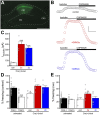GIRK2 splice variants and neuronal G protein-gated K+ channels: implications for channel function and behavior
- PMID: 28487514
- PMCID: PMC5431628
- DOI: 10.1038/s41598-017-01820-2
GIRK2 splice variants and neuronal G protein-gated K+ channels: implications for channel function and behavior
Abstract
Many neurotransmitters directly inhibit neurons by activating G protein-gated inwardly rectifying K+ (GIRK) channels, thereby moderating the influence of excitatory input on neuronal excitability. While most neuronal GIRK channels are formed by GIRK1 and GIRK2 subunits, distinct GIRK2 isoforms generated by alternative splicing have been identified. Here, we compared the trafficking and function of two isoforms (GIRK2a and GIRK2c) expressed individually in hippocampal pyramidal neurons lacking GIRK2. GIRK2a and GIRK2c supported comparable somato-dendritic GIRK currents in Girk2 -/- pyramidal neurons, although GIRK2c achieved a more uniform subcellular distribution in pyramidal neurons and supported inhibitory postsynaptic currents in distal dendrites better than GIRK2a. While over-expression of either isoform in dorsal CA1 pyramidal neurons restored contextual fear learning in a conditional Girk2 -/- mouse line, GIRK2a also enhanced cue fear learning. Collectively, these data indicate that GIRK2 isoform balance within a neuron can impact the processing of afferent inhibitory input and associated behavior.
Conflict of interest statement
The authors declare that they have no competing interests.
Figures







Similar articles
-
G Protein-Gated K+ Channel Ablation in Forebrain Pyramidal Neurons Selectively Impairs Fear Learning.Biol Psychiatry. 2016 Nov 15;80(10):796-806. doi: 10.1016/j.biopsych.2015.10.004. Epub 2015 Nov 10. Biol Psychiatry. 2016. PMID: 26612516 Free PMC article.
-
Developmental regulation of G protein-gated inwardly-rectifying K+ (GIRK/Kir3) channel subunits in the brain.Eur J Neurosci. 2011 Dec;34(11):1724-36. doi: 10.1111/j.1460-9568.2011.07886.x. Epub 2011 Nov 18. Eur J Neurosci. 2011. PMID: 22098295 Free PMC article.
-
Cholesterol up-regulates neuronal G protein-gated inwardly rectifying potassium (GIRK) channel activity in the hippocampus.J Biol Chem. 2017 Apr 14;292(15):6135-6147. doi: 10.1074/jbc.M116.753350. Epub 2017 Feb 17. J Biol Chem. 2017. PMID: 28213520 Free PMC article.
-
G protein-gated inwardly rectifying K+ (GIRK/Kir3) channels: Molecular, cellular, and subcellular diversity.Histol Histopathol. 2025 May;40(5):597-620. doi: 10.14670/HH-18-822. Epub 2024 Sep 26. Histol Histopathol. 2025. PMID: 39434650 Review.
-
Localization and Targeting of GIRK Channels in Mammalian Central Neurons.Int Rev Neurobiol. 2015;123:161-200. doi: 10.1016/bs.irn.2015.05.009. Int Rev Neurobiol. 2015. PMID: 26422985 Review.
Cited by
-
Direct activation of G-protein-gated inward rectifying K+ channels promotes nonrapid eye movement sleep.Sleep. 2019 Mar 1;42(3):zsy244. doi: 10.1093/sleep/zsy244. Sleep. 2019. PMID: 30535004 Free PMC article.
-
Acetylcholine Release Inhibits Distinct Excitatory Inputs Onto Hippocampal CA1 Pyramidal Neurons via Different Cellular and Network Mechanisms.Front Cell Neurosci. 2019 Jun 12;13:267. doi: 10.3389/fncel.2019.00267. eCollection 2019. Front Cell Neurosci. 2019. PMID: 31249513 Free PMC article.
-
Alcohol reverses the effects of KCNJ6 (GIRK2) noncoding variants on excitability of human glutamatergic neurons.Mol Psychiatry. 2023 Feb;28(2):746-758. doi: 10.1038/s41380-022-01818-x. Epub 2022 Oct 7. Mol Psychiatry. 2023. PMID: 36207584 Free PMC article.
-
The antitussive cloperastine improves breathing abnormalities in a Rett Syndrome mouse model by blocking presynaptic GIRK channels and enhancing GABA release.Neuropharmacology. 2020 Oct 1;176:108214. doi: 10.1016/j.neuropharm.2020.108214. Epub 2020 Jul 3. Neuropharmacology. 2020. PMID: 32622786 Free PMC article.
-
Neuronal G protein-gated K+ channels.Am J Physiol Cell Physiol. 2022 Aug 1;323(2):C439-C460. doi: 10.1152/ajpcell.00102.2022. Epub 2022 Jun 15. Am J Physiol Cell Physiol. 2022. PMID: 35704701 Free PMC article. Review.
References
-
- Slesinger, P. A. & Wickman, K. Structure to Function of G Protein-Gated Inwardly Rectifying (GIRK) Channels, In International Review of Neurobiology Vol. 123 (eds R. A. Harris & P. Jenner) 365 (Elsevier, 2015).
Publication types
MeSH terms
Substances
Grants and funding
LinkOut - more resources
Full Text Sources
Other Literature Sources
Molecular Biology Databases
Research Materials
Miscellaneous

